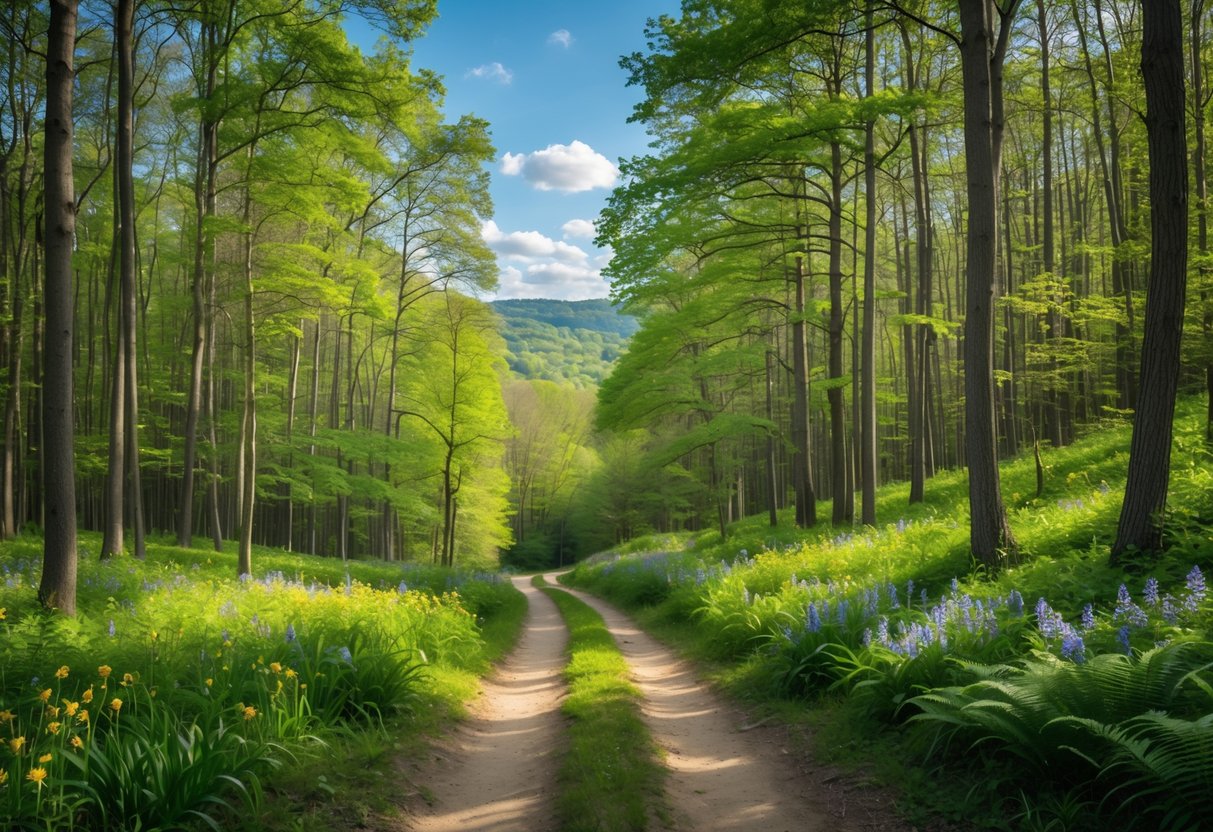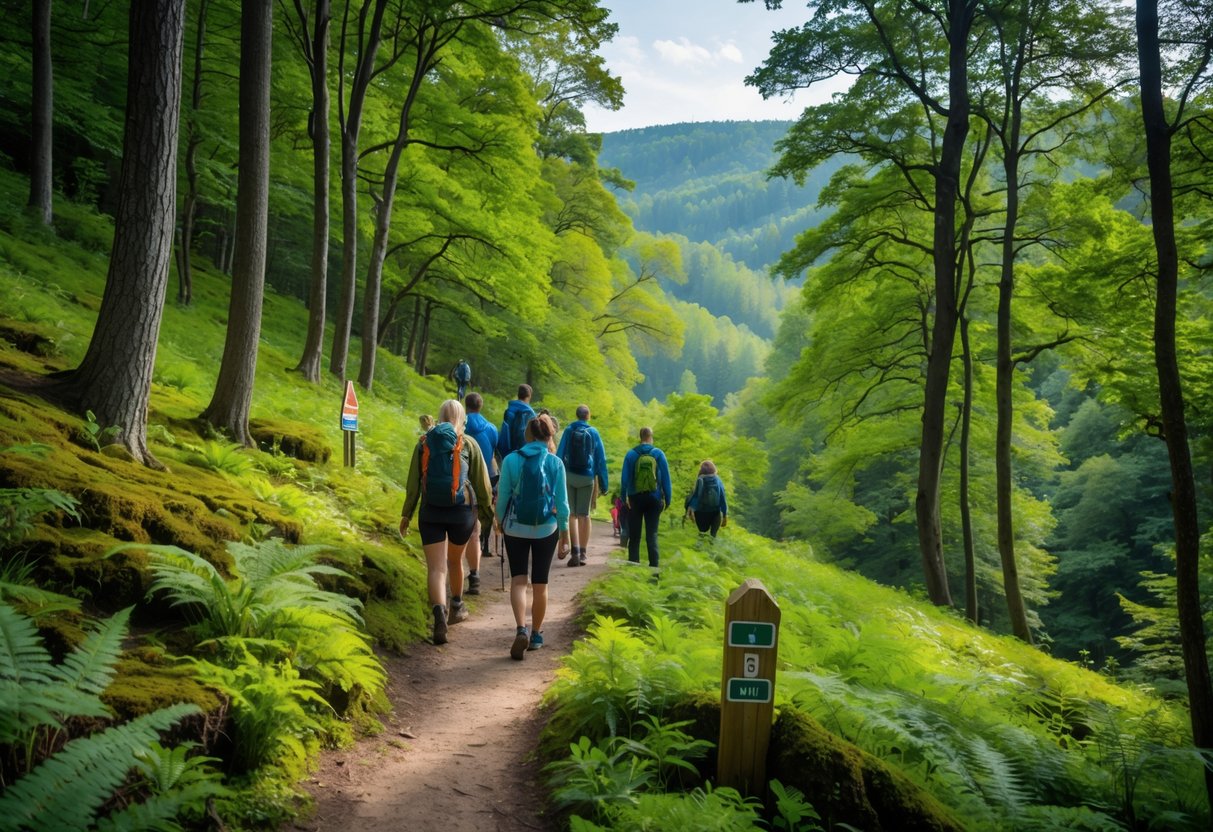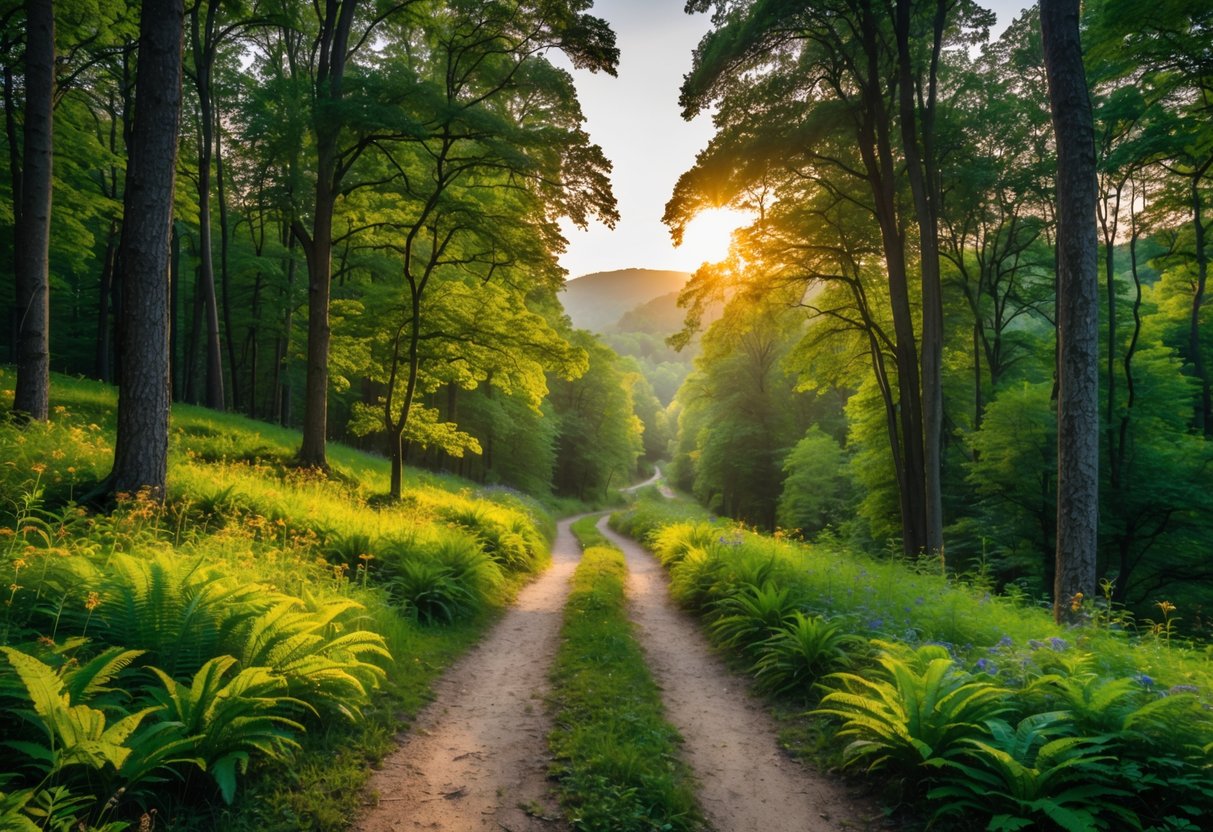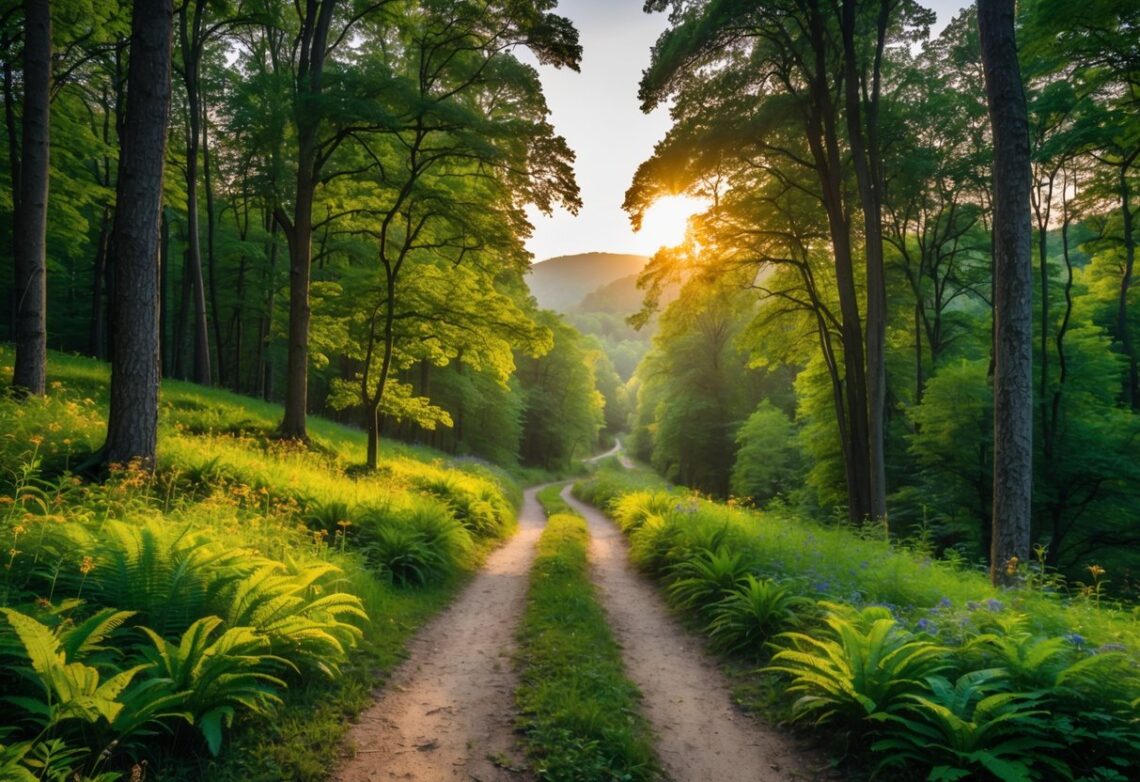Germany offers some of Europe’s most spectacular forest hiking experiences, with over 200,000 kilometers of well-maintained trails winding through diverse landscapes. From the dense woodlands of the Black Forest to the ancient beech groves of the Darß primeval forest on the Baltic coast, these natural havens provide hikers with everything from gentle family walks to challenging multi-day adventures.

The country’s forest trails showcase remarkable variety, including the 660-kilometer Goldsteig Trail through the Bavarian Forest National Park, the historic routes of the Teutoburg Forest with its ancient Externsteine rock formations, and the unique Thuringian Forest with its famous Rennsteig path. Each region presents distinct characteristics, whether it’s spotting wildlife like lynx and wolves in Bavaria or walking through thousand-year-old alder forests that meet sandy beaches in northern Germany.
These forest destinations cater to all skill levels and interests, offering everything from barefoot sensory trails perfect for families to demanding summit climbs in low mountain ranges. The trails remain accessible year-round, with shaded forest paths providing especially welcome relief during warm summer months while winter hiking reveals different seasonal beauty.
Key Takeaways
- Germany features over 200,000 kilometers of forest hiking trails spanning from the Black Forest to the Baltic coast
- The Goldsteig Trail at 660 kilometers is Germany’s longest certified hiking route, while destinations like the Teutoburg Forest offer rich historical significance
- Forest hiking options accommodate all abilities with family-friendly barefoot paths, challenging summit climbs, and year-round accessibility
Top Forest Hiking Destinations and Trails in Germany
Germany offers some of Europe’s most diverse forest hiking experiences, from the dense woodlands of the Black Forest to the alpine meadows of Bavaria. The country’s well-marked trails lead through ancient beech forests, past crystal-clear mountain lakes, and along dramatic river valleys carved through centuries of geological activity.
The Enchanting Black Forest Trails
The Black Forest stretches over 160 kilometers through Baden-Württemberg, offering year-round hiking opportunities for all skill levels. This region combines dense coniferous forests with open meadows and traditional villages.
The Westweg ranks as one of Germany’s premier long-distance trails. This 285-kilometer path runs from Pforzheim to Basel, passing through the heart of the forest. Hikers can tackle sections or complete the full route over 12 days.
The Schluchtensteig provides a more challenging experience. This 119-kilometer trail winds through dramatic gorges and ravines. The path crosses wooden bridges over rushing streams and climbs to scenic viewpoints.
Day hikers enjoy the trails around Feldberg, the region’s highest peak at 1,493 meters. The area offers well-marked circular routes through mixed forests. Many paths lead to traditional Black Forest huts serving local specialties.
Key Trail Features:
- Distance: 285km (Westweg), 119km (Schluchtensteig)
- Difficulty: Moderate to challenging
- Best Season: May through October
- Highlights: Gorges, waterfalls, alpine views
Majestic Hikes in the Bavarian Alps
The Bavarian Alps provide Germany’s most dramatic mountain hiking experiences. Dense forests give way to alpine meadows and rocky peaks along the Austrian border.
The Goldsteig Trail covers 660 kilometers through the Bavarian Forest and Upper Palatinate Forest. The northern section through Bavarian Forest National Park offers more challenging terrain. The southern route provides gentler gradients through pastoral landscapes.
Berchtesgaden National Park features pristine beech and spruce forests. The trail to Königssee lake passes through ancient woodlands before reaching the famous emerald waters. Hikers often spot deer, marmots, and golden eagles.
The Partnach Gorge near Garmisch-Partenkirchen offers a unique forest experience. The trail follows wooden walkways through a narrow limestone gorge. Towering trees create a cathedral-like canopy overhead.
Alpine Forest Highlights:
- Elevation Range: 500m to 2,962m (Zugspitze)
- Wildlife: Red deer, chamois, golden eagles
- Forest Types: Beech, spruce, alpine pine
- Notable Lakes: Königssee, Eibsee, Walchensee
The Scenic Rheinsteig Trail Experience
The Rheinsteig Trail follows the Rhine River for 320 kilometers from Bonn to Wiesbaden. This trail combines river views with dense deciduous forests covering the surrounding hills.
The path winds through the Siebengebirge (Seven Mountains), Germany’s oldest nature conservation area. Ancient beech forests here inspired Brothers Grimm fairy tales. The trail passes medieval castles perched on forested hilltops.
Wine country sections near Rüdesheim offer a unique combination of vineyards and forests. Hikers walk through oak and beech woodlands before descending to riverside wine villages. The trail provides frequent viewpoints overlooking the Rhine Valley.
The Rheinsteig features excellent infrastructure with regular accommodations and transportation links. Most sections can be completed as day hikes using river ferries and regional trains.
Exploring Saxon Switzerland and Painter’s Way
Saxon Switzerland presents Germany’s most unusual forest landscape. Sandstone pillars rise from dense pine and beech forests along the Elbe River near Dresden.
The Painter’s Way (Malerweg) forms a 112-kilometer loop through this dramatic terrain. The trail earned its name from 18th-century artists who painted these romantic landscapes. Dense forests frame views of towering rock formations.
Bastei Bridge provides the region’s most famous viewpoint. The trail approaches through mixed forests before emerging onto dramatic sandstone platforms. Wooden bridges connect the rock pinnacles high above the forest canopy.
The Kirnitzsch Valley offers gentler forest hiking. This route follows a clear mountain stream through narrow gorges lined with ancient trees. The path leads to hidden waterfalls and secluded forest clearings.
Trail Specifications:
- Total Distance: 112km loop
- Daily Stages: 8 sections (8-23km each)
- Terrain: Sandstone cliffs, forest paths
- Unique Features: Rock formations, historic bridges
Iconic Landscapes, Highlights, and Practical Hiking Tips

Germany’s forests offer wine-covered valleys, dramatic gorges, and historic castles along major rivers. These landscapes provide unique hiking experiences that combine natural beauty with cultural heritage throughout the country.
Ahr Valley Vineyards and Red Wine Trails
The Ahr Valley creates one of Germany’s most scenic hiking destinations. Steep vineyards rise from the valley floor along terraced hillsides.
Red wine trails wind through the region’s famous Pinot Noir vineyards. Hikers can follow marked paths that connect small wine villages and tasting rooms.
Popular Trail Features:
- Rotweinwanderweg (Red Wine Trail) – 35 kilometers total
- Vineyard terraces with Rhine Valley views
- Historic wine cellars and tastings
- Valley overlooks from forested ridges
The best hiking season runs from April through October. Spring brings blooming fruit trees while autumn offers harvest activities and colorful leaves.
Trail markers use red grape symbols to guide hikers. Many sections include steep climbs through forest areas above the vineyards.
Discovering the Partnachklamm Gorge
Partnachklamm Gorge near Garmisch-Partenkirchen offers dramatic Alpine forest hiking. The gorge cuts through limestone cliffs with waterfalls and rushing streams.
A metal walkway follows the gorge floor through narrow canyon walls. Hikers walk beside the Partnach River as it flows through carved rock formations.
Trail Highlights:
- 700-meter walkway through the gorge
- Waterfalls up to 80 meters high
- Alpine forest paths above the canyon
- Mountain views toward Zugspitze
The gorge stays cool even in summer due to its depth and forest cover. Hikers should bring waterproof jackets since mist from waterfalls creates wet conditions.
Winter access requires special ice cleats. The frozen waterfalls and ice formations create different scenery during cold months.
Castles, Rivers, and Cultural Attractions
Germany’s forest trails often lead to historic castles and river viewpoints. The Rhine River region contains many hiking routes that connect cultural sites.
Castle ruins sit on forested hilltops throughout the country. Hikers can reach these sites through marked forest paths that offer views of river valleys below.
Key Locations:
- Rhine River trails near Bonn and Wiesbaden
- Castle hiking routes in the Middle Rhine Valley
- Forest paths connecting historic towns
- River overlooks from wooded ridges
Many trails start from train stations in cities like Bonn or Wiesbaden. Public transport connects hiking areas to urban centers throughout Germany.
Forest paths often include information boards about local history and wildlife. These educational stops help hikers learn about the region’s cultural background.
Essential Tips for Forest Hiking in Germany
German forest trails use standardized marking systems with colored symbols. Hikers should learn these symbols before starting their hikes.
Trail Marking Colors:
- Yellow: Local day hikes
- Red: Regional connecting trails
- White: Long-distance routes
- Blue: Premium hiking paths
Weather changes quickly in forested areas. Hikers need layered clothing and rain protection even during summer months.
Most forest areas require hikers to stay on marked trails. This protects wildlife and prevents damage to sensitive forest ecosystems.
Recommended Gear:
- Waterproof hiking boots
- Trail map and compass
- First aid supplies
- Plenty of water
Emergency contact numbers should be programmed into phones before hiking. Many forest areas have limited cell phone coverage in valleys and dense woods.
Frequently Asked Questions

Planning a forest hike in Germany involves understanding the best trails, regional landscapes, and practical considerations. These common questions cover essential information about Germany’s diverse forest hiking opportunities and preparation requirements.
What are the top-rated forest hiking trails in Germany?
The Rennsteig trail in the Thuringian Forest ranks among Germany’s most famous long-distance hiking routes. This historic path stretches from Eisenach to the Saale dams in the southeast.
The Black Forest offers the Schluchtensteig and Westweg trails for multi-day adventures. These premium hiking trails showcase the region’s dense forests and mountain views.
The Goldsteig trail in the Bavarian Forest connects Passau to Marktredwitz. This route passes through Germany’s oldest national park with pristine wilderness areas.
The Forest and Beach Route in Darß Forest provides a unique 10-kilometer experience. Hikers can explore ancient alder and beech forests while enjoying Baltic Sea views.
Which German regions offer the most picturesque forest landscapes for hiking?
The Black Forest in Baden-Württemberg stretches 160 kilometers from north to south. Dense northern forests transition to southern trails with Alpine views.
The Bavarian Forest National Park borders the Czech Republic. This region features moorlands, nature reserves, and wildlife viewing opportunities.
The Darß Forest near Rostock covers 5,800 hectares on the Baltic coast. Ancient primeval forest meets sandy beaches in this unique landscape.
The Thuringian Forest contains four national natural landscapes. Varied terrain accommodates both leisurely family walks and challenging mountain routes.
How do you prepare for a forest hike in Germany’s varying climates?
Forest hiking works year-round in Germany with proper preparation. Summer hiking requires sun protection and extra water for warm weather conditions.
Winter forest hikes need insulated clothing and waterproof boots. Snow and ice can make trails slippery and more challenging to navigate.
Spring and fall offer mild temperatures but variable weather. Layered clothing allows hikers to adjust for changing conditions throughout the day.
Rain gear remains essential regardless of season. German forests can experience sudden weather changes that catch unprepared hikers off guard.
What are some safety tips for hiking in German forests?
Stick to marked trails in protected areas like Vorpommersche Boddenlandschaft National Park. Some forest sections restrict access to designated paths only.
Inform others about hiking plans and expected return times. Forest areas may have limited cell phone coverage for emergency communication.
Carry a first aid kit and basic navigation tools. GPS devices or detailed trail maps help prevent getting lost in dense forest areas.
Check weather conditions before departing. Storms can create dangerous conditions with falling branches and flooding in forest valleys.
Are there guided hiking tours available in German forest trails?
Professional guides offer tours in major forest regions throughout Germany. Local tourism offices provide information about scheduled group hikes and private guide services.
The Black Forest region has numerous tour operators. These services cater to different fitness levels and interests, from cultural walks to challenging mountain hikes.
Bavarian Forest National Park offers ranger-led programs. These educational tours focus on wildlife observation and forest conservation topics.
Specialized pilgrimage trail guides operate in the Thuringian Forest. Six different pilgrimage routes and Luther trails provide historical and religious context.
What wildlife should you expect to encounter while hiking in Germany’s forests?
The Bavarian Forest National Park hosts large mammals including bears, lynx, and wolves. Elk populations also inhabit this protected wilderness area.
Wild cats live in certain forest regions, particularly around Hütscheroda. Visitors can learn about local wildlife at educational centers near hiking trails.
Forest birds include various species adapted to different forest types. Beech and pine forests support different bird communities throughout the seasons.
Smaller mammals like deer, foxes, and forest rodents appear commonly on trails. Early morning and evening hikes offer the best wildlife viewing opportunities.





